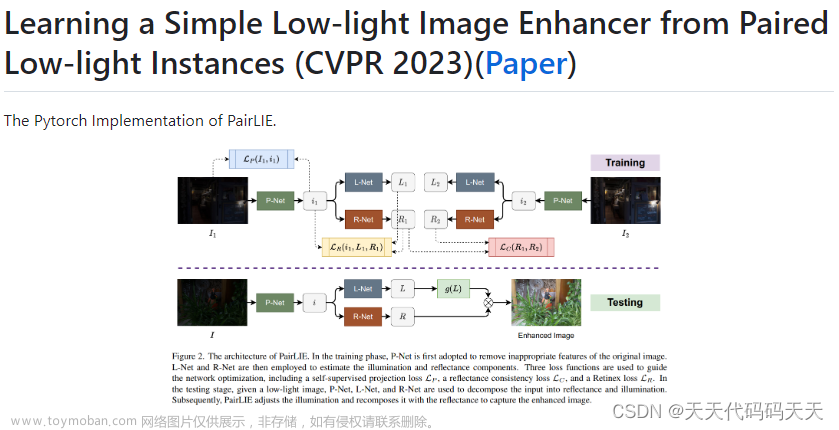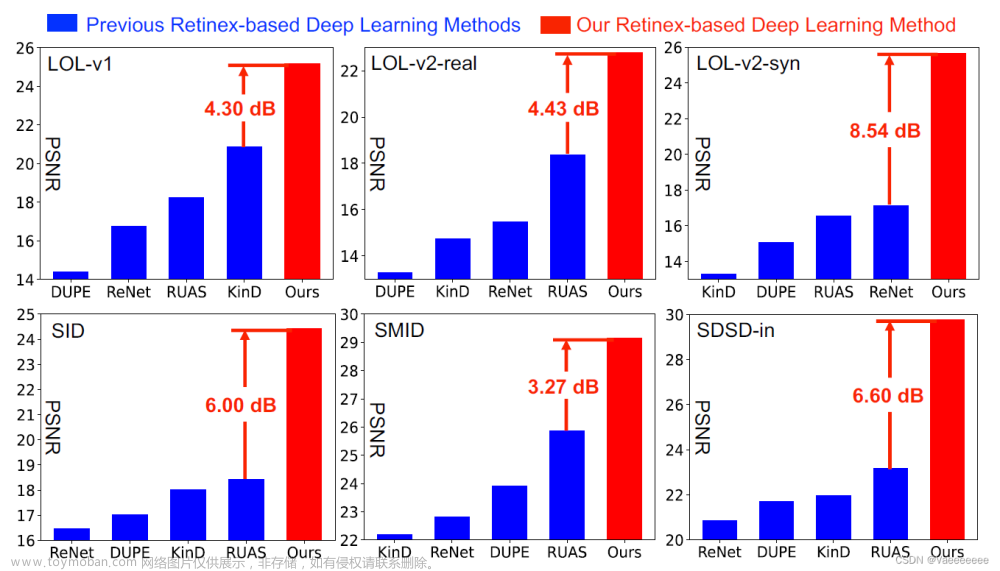目录
介绍
效果
模型信息
项目
代码
下载
C# OpenCvSharp DNN Low Light image Enhancement
介绍
github地址:https://github.com/zhenqifu/PairLIE

效果


模型信息
Model Properties
-------------------------
---------------------------------------------------------------
Inputs
-------------------------
name:input
tensor:Float[1, 3, 512, 512]
name:exposure
tensor:Float[1]
---------------------------------------------------------------
Outputs
-------------------------
name:output
tensor:Float[1, 3, 512, 512]
---------------------------------------------------------------
项目

代码
using OpenCvSharp;
using OpenCvSharp.Dnn;
using System;
using System.Collections.Generic;
using System.Drawing;
using System.IO;
using System.Linq;
using System.Linq.Expressions;
using System.Numerics;
using System.Reflection;
using System.Windows.Forms;
namespace OpenCvSharp_DNN_Demo
{
public partial class frmMain : Form
{
public frmMain()
{
InitializeComponent();
}
string fileFilter = "*.*|*.bmp;*.jpg;*.jpeg;*.tiff;*.tiff;*.png";
string image_path = "";
DateTime dt1 = DateTime.Now;
DateTime dt2 = DateTime.Now;
string modelpath;
int inpHeight;
int inpWidth;
Net opencv_net;
Mat BN_image;
Mat image;
Mat result_image;
private void button1_Click(object sender, EventArgs e)
{
OpenFileDialog ofd = new OpenFileDialog();
ofd.Filter = fileFilter;
if (ofd.ShowDialog() != DialogResult.OK) return;
pictureBox1.Image = null;
pictureBox2.Image = null;
textBox1.Text = "";
image_path = ofd.FileName;
pictureBox1.Image = new Bitmap(image_path);
image = new Mat(image_path);
}
private void Form1_Load(object sender, EventArgs e)
{
modelpath = "model/pairlie_512x512.onnx";
inpHeight = 512;
inpWidth = 512;
opencv_net = CvDnn.ReadNetFromOnnx(modelpath);
image_path = "test_img/1.png";
pictureBox1.Image = new Bitmap(image_path);
}
private unsafe void button2_Click(object sender, EventArgs e)
{
if (image_path == "")
{
return;
}
textBox1.Text = "检测中,请稍等……";
pictureBox2.Image = null;
Application.DoEvents();
image = new Mat(image_path);
int srch = image.Rows;
int srcw = image.Cols;
BN_image = CvDnn.BlobFromImage(image, 1 / 255.0, new OpenCvSharp.Size(inpWidth, inpHeight), new Scalar(0, 0, 0), true, false);
opencv_net.SetInput(BN_image, "input");
Mat one = new Mat(1,1,MatType.CV_32F,new float[] { 0.5f});
Mat exposure = CvDnn.BlobFromImage(one);
opencv_net.SetInput(exposure, "exposure");
//模型推理,读取推理结果
Mat[] outs = new Mat[1] { new Mat() };
string[] outBlobNames = opencv_net.GetUnconnectedOutLayersNames().ToArray();
dt1 = DateTime.Now;
opencv_net.Forward(outs, outBlobNames);
dt2 = DateTime.Now;
float* pdata = (float*)outs[0].Data;
int out_h = outs[0].Size(2);
int out_w = outs[0].Size(3);
int channel_step = out_h * out_w;
float[] data = new float[channel_step * 3];
for (int i = 0; i < data.Length; i++)
{
data[i] = pdata[i] * 255;
if (data[i] < 0)
{
data[i] = 0;
}
else if (data[i] > 255)
{
data[i] = 255;
}
}
float[] temp_r = new float[out_h * out_w];
float[] temp_g = new float[out_h * out_w];
float[] temp_b = new float[out_h * out_w];
Array.Copy(data, temp_r, out_h * out_w);
Array.Copy(data, out_h * out_w, temp_g, 0, out_h * out_w);
Array.Copy(data, out_h * out_w * 2, temp_b, 0, out_h * out_w);
Mat rmat = new Mat(out_h, out_w, MatType.CV_32F, temp_r);
Mat gmat = new Mat(out_h, out_w, MatType.CV_32F, temp_g);
Mat bmat = new Mat(out_h, out_w, MatType.CV_32F, temp_b);
result_image = new Mat();
Cv2.Merge(new Mat[] { bmat, gmat, rmat }, result_image);
result_image.ConvertTo(result_image, MatType.CV_8UC3);
Cv2.Resize(result_image, result_image, new OpenCvSharp.Size(srcw, srch));
pictureBox2.Image = new Bitmap(result_image.ToMemoryStream());
textBox1.Text = "推理耗时:" + (dt2 - dt1).TotalMilliseconds + "ms";
}
private void pictureBox2_DoubleClick(object sender, EventArgs e)
{
Common.ShowNormalImg(pictureBox2.Image);
}
private void pictureBox1_DoubleClick(object sender, EventArgs e)
{
Common.ShowNormalImg(pictureBox1.Image);
}
}
}
using OpenCvSharp;
using OpenCvSharp.Dnn;
using System;
using System.Collections.Generic;
using System.Drawing;
using System.IO;
using System.Linq;
using System.Linq.Expressions;
using System.Numerics;
using System.Reflection;
using System.Windows.Forms;
namespace OpenCvSharp_DNN_Demo
{
public partial class frmMain : Form
{
public frmMain()
{
InitializeComponent();
}
string fileFilter = "*.*|*.bmp;*.jpg;*.jpeg;*.tiff;*.tiff;*.png";
string image_path = "";
DateTime dt1 = DateTime.Now;
DateTime dt2 = DateTime.Now;
string modelpath;
int inpHeight;
int inpWidth;
Net opencv_net;
Mat BN_image;
Mat image;
Mat result_image;
private void button1_Click(object sender, EventArgs e)
{
OpenFileDialog ofd = new OpenFileDialog();
ofd.Filter = fileFilter;
if (ofd.ShowDialog() != DialogResult.OK) return;
pictureBox1.Image = null;
pictureBox2.Image = null;
textBox1.Text = "";
image_path = ofd.FileName;
pictureBox1.Image = new Bitmap(image_path);
image = new Mat(image_path);
}
private void Form1_Load(object sender, EventArgs e)
{
modelpath = "model/pairlie_512x512.onnx";
inpHeight = 512;
inpWidth = 512;
opencv_net = CvDnn.ReadNetFromOnnx(modelpath);
image_path = "test_img/1.png";
pictureBox1.Image = new Bitmap(image_path);
}
private unsafe void button2_Click(object sender, EventArgs e)
{
if (image_path == "")
{
return;
}
textBox1.Text = "检测中,请稍等……";
pictureBox2.Image = null;
Application.DoEvents();
image = new Mat(image_path);
int srch = image.Rows;
int srcw = image.Cols;
BN_image = CvDnn.BlobFromImage(image, 1 / 255.0, new OpenCvSharp.Size(inpWidth, inpHeight), new Scalar(0, 0, 0), true, false);
opencv_net.SetInput(BN_image, "input");
Mat one = new Mat(1,1,MatType.CV_32F,new float[] { 0.5f});
Mat exposure = CvDnn.BlobFromImage(one);
opencv_net.SetInput(exposure, "exposure");
//模型推理,读取推理结果
Mat[] outs = new Mat[1] { new Mat() };
string[] outBlobNames = opencv_net.GetUnconnectedOutLayersNames().ToArray();
dt1 = DateTime.Now;
opencv_net.Forward(outs, outBlobNames);
dt2 = DateTime.Now;
float* pdata = (float*)outs[0].Data;
int out_h = outs[0].Size(2);
int out_w = outs[0].Size(3);
int channel_step = out_h * out_w;
float[] data = new float[channel_step * 3];
for (int i = 0; i < data.Length; i++)
{
data[i] = pdata[i] * 255;
if (data[i] < 0)
{
data[i] = 0;
}
else if (data[i] > 255)
{
data[i] = 255;
}
}
float[] temp_r = new float[out_h * out_w];
float[] temp_g = new float[out_h * out_w];
float[] temp_b = new float[out_h * out_w];
Array.Copy(data, temp_r, out_h * out_w);
Array.Copy(data, out_h * out_w, temp_g, 0, out_h * out_w);
Array.Copy(data, out_h * out_w * 2, temp_b, 0, out_h * out_w);
Mat rmat = new Mat(out_h, out_w, MatType.CV_32F, temp_r);
Mat gmat = new Mat(out_h, out_w, MatType.CV_32F, temp_g);
Mat bmat = new Mat(out_h, out_w, MatType.CV_32F, temp_b);
result_image = new Mat();
Cv2.Merge(new Mat[] { bmat, gmat, rmat }, result_image);
result_image.ConvertTo(result_image, MatType.CV_8UC3);
Cv2.Resize(result_image, result_image, new OpenCvSharp.Size(srcw, srch));
pictureBox2.Image = new Bitmap(result_image.ToMemoryStream());
textBox1.Text = "推理耗时:" + (dt2 - dt1).TotalMilliseconds + "ms";
}
private void pictureBox2_DoubleClick(object sender, EventArgs e)
{
Common.ShowNormalImg(pictureBox2.Image);
}
private void pictureBox1_DoubleClick(object sender, EventArgs e)
{
Common.ShowNormalImg(pictureBox1.Image);
}
}
}
下载
源码下载文章来源:https://www.toymoban.com/news/detail-832255.html
文章来源地址https://www.toymoban.com/news/detail-832255.html
到了这里,关于C# OpenCvSharp DNN Low Light image Enhancement的文章就介绍完了。如果您还想了解更多内容,请在右上角搜索TOY模板网以前的文章或继续浏览下面的相关文章,希望大家以后多多支持TOY模板网!













